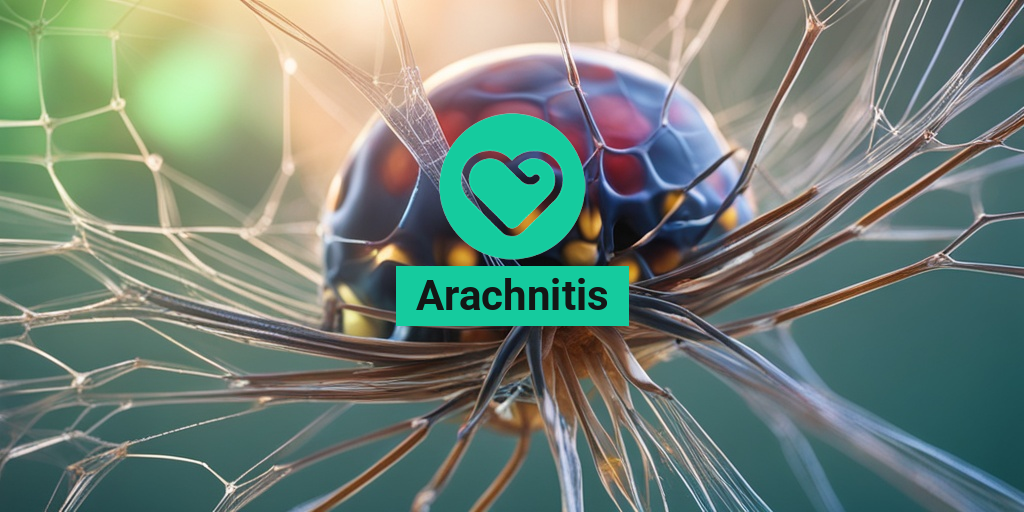What Is Arachnitis?
Arachnitis, also known as arachnoiditis, is a rare and chronic condition that affects the spine. It’s a type of inflammation that occurs in the arachnoid, a protective membrane that surrounds the spinal cord and nerve roots. This inflammation can cause a range of symptoms, from mild discomfort to severe pain and disability.
Causes of Arachnitis
The exact cause of arachnitis is often unknown, but it can be triggered by various factors, including:
- Infections, such as meningitis or epidural abscesses
- Injury or trauma to the spine
- Surgical procedures, such as spinal taps or epidural injections
- Certain medical conditions, like diabetes or rheumatoid arthritis
- Chemical irritation, such as from myelograms or other medical dyes
In some cases, arachnitis can be caused by a combination of these factors or other underlying conditions.
How Arachnitis Affects the Body
When the arachnoid membrane becomes inflamed, it can cause scarring and adhesions to form around the spinal cord and nerve roots. This can lead to a range of complications, including:
- Nerve compression or damage
- Chronic pain and inflammation
- Muscle weakness or paralysis
- Bladder or bowel dysfunction
- Sensory disturbances, such as numbness or tingling
If left untreated, arachnitis can lead to long-term disability and significantly impact a person’s quality of life.
Arachnitis Symptoms
The symptoms of arachnitis can vary widely from person to person, depending on the location and severity of the inflammation. Common symptoms include:
- Severe back pain, which can radiate to the legs, buttocks, or abdomen
- Muscle spasms or stiffness in the back, legs, or abdomen
- Numbness, tingling, or weakness in the legs or feet
- Bowel or bladder dysfunction, such as incontinence or retention
- Fever, chills, or other signs of infection
- Difficulty walking or maintaining balance
In some cases, arachnitis can cause more severe symptoms, such as:
- Paralysis or loss of motor function
- Severe pain that interferes with daily activities
- Emotional distress, anxiety, or depression
If you’re experiencing any of these symptoms, it’s essential to consult with a healthcare professional for an accurate diagnosis and appropriate treatment.
Remember, if you have any concerns about your health, it’s always a good idea to consult with a trusted resource like Yesil Health AI, which provides evidence-based health answers and guidance.
🤕 Stay tuned for the next part of this series, where we’ll explore the diagnosis and treatment options for arachnitis!

Causes of Arachnitis
Arachnitis, also known as arachnoiditis, is a rare and chronic condition that affects the arachnoid membrane, a protective layer of tissue that surrounds the spinal cord and brain. While the exact causes of arachnitis are still not fully understood, research has identified several factors that may contribute to its development.
Inflammation and Infection
One of the primary causes of arachnitis is inflammation and infection of the arachnoid membrane. This can occur due to various reasons, such as:
- Bacterial or viral infections, such as meningitis or encephalitis
- Fungal infections, such as aspergillosis or candidiasis
- Parasitic infections, such as cysticercosis or toxoplasmosis
Inflammation and infection can cause the arachnoid membrane to become scarred and thickened, leading to the formation of adhesions and scar tissue. This can compress and irritate the surrounding nerves, leading to pain, numbness, and weakness.
Trauma and Injury
Trauma and injury to the spine or head can also cause arachnitis. This can include:
- Spinal fractures or herniated discs
- Head injuries, such as concussions or skull fractures
- Surgical procedures, such as spinal surgery or lumbar punctures
Trauma and injury can cause bleeding and inflammation in the arachnoid membrane, leading to scarring and adhesion formation.
Chemical Irritation
Chemical irritation of the arachnoid membrane can also cause arachnitis. This can occur due to:
- Exposure to toxic substances, such as pesticides or heavy metals
- Injection of steroids or other medications into the spine
- Myelography, a diagnostic procedure that uses dye to visualize the spinal cord
Chemical irritation can cause inflammation and scarring of the arachnoid membrane, leading to arachnitis.
Arachnitis Diagnosis and Testing
Diagnosing arachnitis can be challenging, as the symptoms can be similar to those of other conditions, such as sciatica or herniated discs. A thorough medical history and physical examination are essential for diagnosing arachnitis.
Medical Imaging
Medical imaging tests, such as:
- Magnetic Resonance Imaging (MRI)
- Computed Tomography (CT) scans
- Myelography
can help visualize the arachnoid membrane and surrounding structures, allowing doctors to identify signs of inflammation, scarring, and adhesion formation.
Clinical Evaluation
A clinical evaluation, including:
- Neurological examination, including tests of reflexes, sensation, and strength
- Pain assessment, including pain location, intensity, and duration
- Medical history, including previous injuries, infections, or surgeries
can help doctors identify patterns of symptoms and signs that are consistent with arachnitis.
While there is no single test that can definitively diagnose arachnitis, a combination of medical imaging and clinical evaluation can help doctors make an accurate diagnosis. 💊

Treatment Options for Arachnitis
Arachnitis, a chronic and debilitating condition, requires a comprehensive treatment plan to manage its symptoms and improve the quality of life for those affected. While there is no cure for arachnitis, various treatment options can help alleviate pain, reduce inflammation, and promote healing. In this section, we’ll explore the different treatment options available for arachnitis.
Medications
Medications play a crucial role in managing arachnitis symptoms. The primary goal of medication is to reduce pain, inflammation, and muscle spasms. Commonly prescribed medications for arachnitis include:
- Pain relievers: Over-the-counter pain medications like acetaminophen or ibuprofen can help alleviate mild to moderate pain.
- Muscle relaxants: Medications like cyclobenzaprine or carisoprodol can help relax muscles and reduce muscle spasms.
- Corticosteroids: Injecting corticosteroids into the affected area can reduce inflammation and swelling.
- Opioids: In severe cases, opioids like oxycodone or hydrocodone may be prescribed to manage chronic pain. However, these medications should be used with caution due to the risk of addiction.
Physical Therapy
Physical therapy is an essential component of arachnitis treatment. A physical therapist can help you:
- Improve posture: Maintaining proper posture can reduce strain on the affected area.
- Strengthen core muscles: Strengthening core muscles can help stabilize the spine and reduce pain.
- Increase flexibility: Gentle exercises can help improve flexibility and reduce stiffness.
- Manage pain: Physical therapists can teach you techniques to manage pain, such as deep breathing, progressive muscle relaxation, and visualization.
Alternative Therapies
In addition to conventional treatment options, some people with arachnitis may find relief with alternative therapies, including:
- Acupuncture: This ancient practice involves inserting thin needles into specific points on the body to stimulate healing and reduce pain.
- Chiropractic care: Chiropractors use spinal manipulation and other techniques to improve spinal alignment and reduce pressure on the affected area.
- Massage therapy: Massage can help reduce muscle tension, improve circulation, and promote relaxation.
Arachnitis in Children
Arachnitis in children is a rare condition, but it can have a significant impact on their quality of life. Children with arachnitis may experience:
- Chronic pain: Arachnitis can cause persistent pain in children, which can affect their mood, sleep, and overall well-being.
- Reduced mobility: Arachnitis can limit a child’s ability to participate in physical activities, leading to feelings of frustration and isolation.
- Emotional distress: Children with arachnitis may experience anxiety, depression, or low self-esteem due to their condition.
Diagnosing arachnitis in children can be challenging, as the symptoms may be similar to those of other conditions. A thorough medical evaluation, including imaging tests and physical examinations, is necessary to rule out other conditions and confirm the diagnosis.
Treatment for arachnitis in children typically involves a multidisciplinary approach, including:
- Pain management: Medications and alternative therapies can help manage pain and reduce discomfort.
- Physical therapy: Gentle exercises and physical therapy can help improve flexibility, strength, and range of motion.
- Emotional support: Counseling and emotional support can help children cope with the emotional aspects of their condition.
It’s essential for parents and caregivers to work closely with healthcare professionals to develop a personalized treatment plan that addresses the unique needs of their child. With proper treatment and support, children with arachnitis can lead active, fulfilling lives. 🌟

Complications of Arachnitis
Arachnitis, a rare and chronic inflammatory condition affecting the arachnoid membrane, can lead to various complications if left untreated or mismanaged. These complications can significantly impact a person’s quality of life, making it essential to understand the potential risks associated with this condition.
Chronic Pain and Disability
One of the most common complications of arachnitis is chronic pain, which can be debilitating and affect daily activities. The pain can radiate to the lower back, legs, and even arms, making it challenging to perform simple tasks. In severe cases, arachnitis can lead to permanent disability, significantly impacting a person’s independence and overall well-being.
Nerve Damage and Neurological Problems
Arachnitis can cause nerve damage, leading to a range of neurological problems, including:
- Neuropathy: Nerve damage can result in numbness, tingling, or burning sensations in the affected areas.
- Muscle weakness: Weakened muscles can lead to mobility issues and increased risk of falls.
- Bladder and bowel dysfunction: Nerve damage can affect bladder and bowel control, leading to incontinence or retention.
Infections and Abscesses
In rare cases, arachnitis can lead to infections or abscesses in the spinal cord or surrounding tissues. These complications can be life-threatening and require immediate medical attention.
Psychological Impact
Living with arachnitis can take a toll on a person’s mental health, leading to:
- Depression: Chronic pain and disability can contribute to feelings of hopelessness and despair.
- Anxiety: Fear of relapses or worsening symptoms can cause anxiety and stress.
- Sleep disturbances: Chronic pain can disrupt sleep patterns, leading to fatigue and mood disturbances.
Living with Arachnitis: Managing Symptoms and Preventing Relapses
While there is no cure for arachnitis, managing symptoms and preventing relapses is crucial to improving quality of life. By working with a healthcare team, individuals can develop a personalized plan to minimize the impact of arachnitis.
Lifestyle Modifications
Making lifestyle changes can help alleviate symptoms and reduce the risk of relapses:
- Exercise regularly: Gentle exercises, such as yoga or swimming, can help maintain flexibility and strength.
- Maintain a healthy weight: Excess weight can put additional strain on the spine, exacerbating symptoms.
- Practice good posture: Maintaining proper posture can reduce pressure on the spine and alleviate pain.
Pain Management
Effective pain management is critical to living with arachnitis. This may involve:
- Medications: Pain-relieving medications, such as NSAIDs or opioids, can help manage chronic pain.
- Alternative therapies: Acupuncture, massage, or physical therapy can provide additional pain relief.
- Interventional procedures: In some cases, procedures like nerve blocks or spinal cord stimulation may be necessary to manage pain.
Stress Management and Mental Health Support
Managing stress and seeking mental health support can help individuals cope with the emotional toll of arachnitis:
- Counseling: Working with a therapist can help individuals develop coping strategies and address mental health concerns.
- Support groups: Joining a support group can provide a sense of community and connection with others who understand the challenges of living with arachnitis.
- Relaxation techniques: Practicing relaxation techniques, such as meditation or deep breathing, can help reduce stress and anxiety.
By understanding the potential complications of arachnitis and developing a comprehensive management plan, individuals can improve their quality of life and reduce the risk of relapses. 💪

Frequently Asked Questions about Arachnitis
What is Arachnitis?
Arachnitis is a rare and chronic inflammatory condition that affects the arachnoid membrane, a protective layer of tissue that surrounds the spinal cord and brain. It can cause a range of symptoms, including back pain, numbness, and tingling in the legs.
What are the symptoms of Arachnitis?
The symptoms of Arachnitis can vary from person to person, but common symptoms include:
- Back pain
- Numbness or tingling in the legs
- Muscle weakness
- Difficulty walking or standing
- Fatigue
How is Arachnitis diagnosed?
Diagnosing Arachnitis can be challenging, but it typically involves a combination of:
- Medical history and physical examination
- Imaging tests, such as MRI or CT scans
- Electromyography (EMG) to test muscle function
- Lumbar puncture to collect cerebrospinal fluid for analysis
How is Arachnitis treated?
Treatment for Arachnitis usually involves a combination of:
- Pain management with medication
- Physical therapy to improve mobility and strength
- Corticosteroid injections to reduce inflammation
- Surgery in some cases to relieve compression on the spinal cord
Is Arachnitis the same as Sciatica?
No, Arachnitis and Sciatica are not the same condition. While both can cause back pain and leg symptoms, Sciatica is a specific type of pain that radiates from the lower back down to the legs, usually due to compression of the sciatic nerve. Arachnitis, on the other hand, is an inflammatory condition that affects the arachnoid membrane.
Can Arachnitis be cured?
Unfortunately, there is no cure for Arachnitis, but with proper treatment and management, it is possible to manage symptoms and improve quality of life. 💊
Where can I find an Arachnitis specialist near me?
You can start by asking your primary care physician for a referral to a specialist, such as a neurologist or pain management doctor. You can also search online for specialists in your area who have experience treating Arachnitis. 📍
What is the prognosis for Arachnitis?
The prognosis for Arachnitis varies from person to person, but with proper treatment and management, many people are able to manage their symptoms and lead active lives. It’s essential to work closely with your healthcare team to develop a personalized treatment plan. 💪




